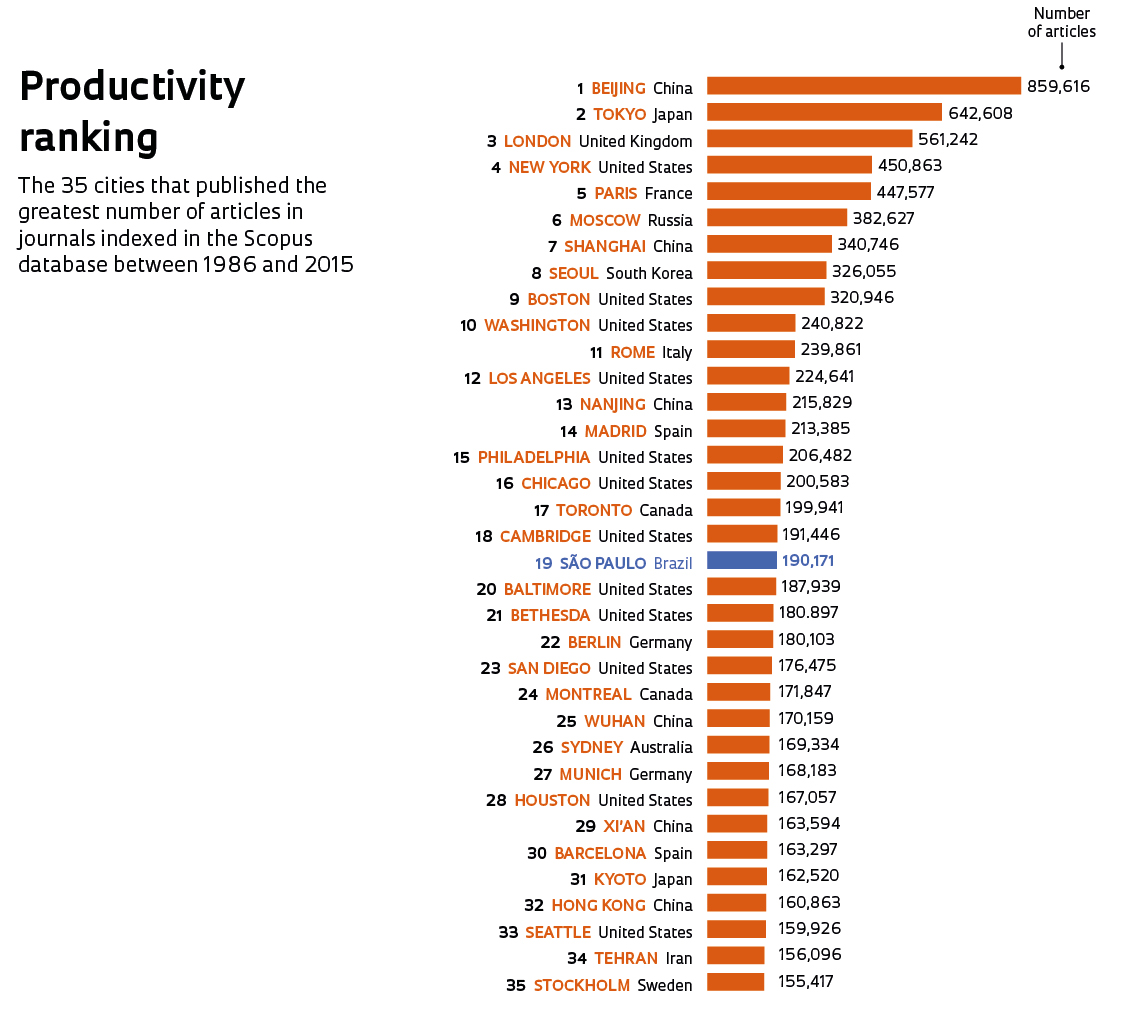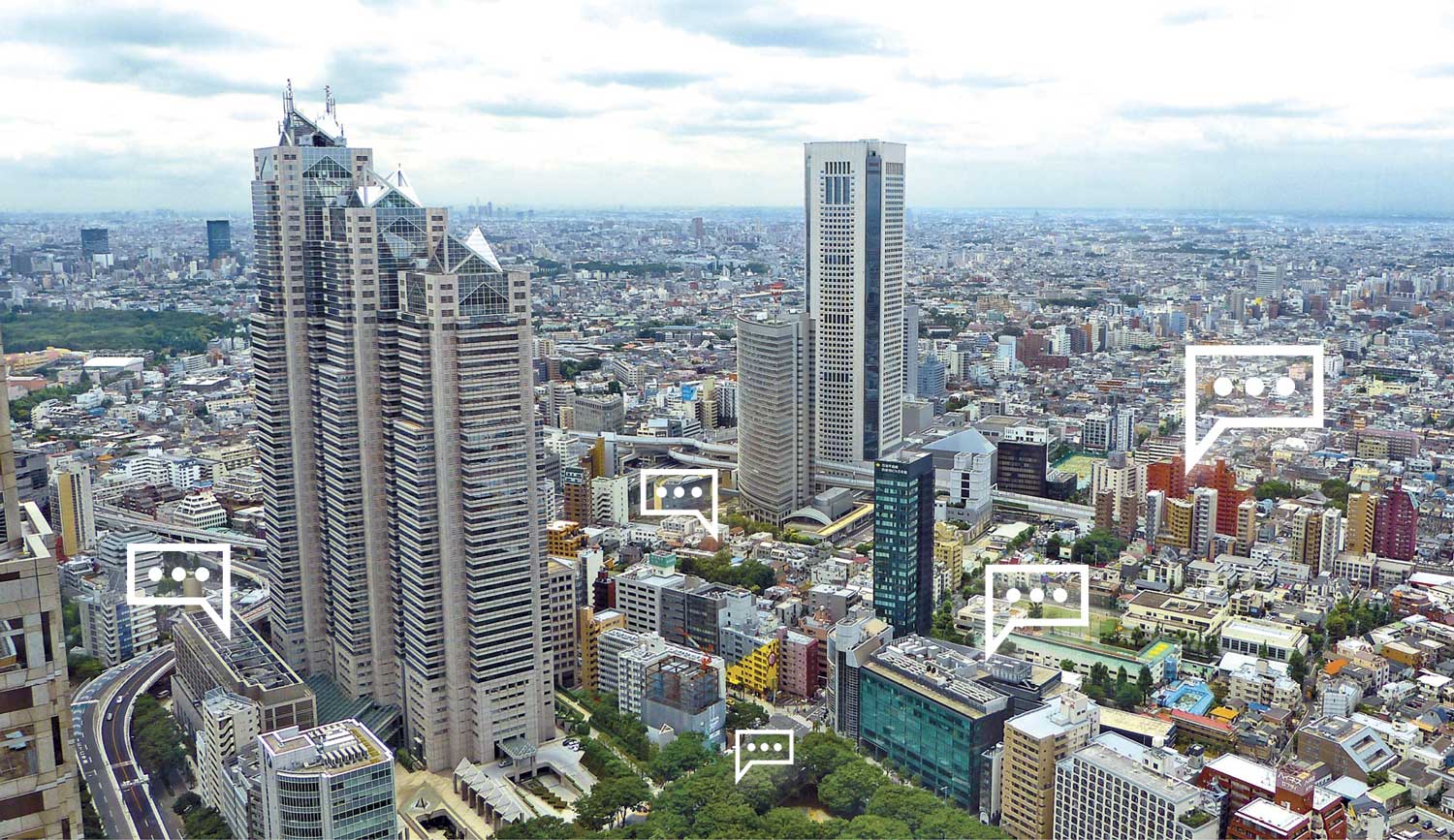Astudy published in the Journal of Informetrics in August analyzed articles produced in 2,194 cities worldwide over the last three decades and identified a shift in scientific output from developed countries to emerging nations. According to the study, in quantitative terms, countries such as China, India, Iran, and Brazil have come to occupy prominent positions in global science.
From 1986 to 1995, the 15 cities that published the most research papers worldwide were predominantly located in the United States and Europe, but from 2006 to 2015, the sources of scientific output became more diverse, with Beijing, Seoul, Tehran, and Sao Paulo entering the list. “It seems quite clear that this is not a temporary phenomenon, but a consistent trend,” says György Csomós, lead author of the study and a professor in the Engineering Department at the University of Debrecen, Hungary. “The research impact in these new regions is still lower than that of cities in the United States and Europe, but our study did not evaluate citations,” he says.
 The study selected locations with at least 1,000 published articles indexed in the Elsevier Scopus database between 1986 and 2015. György Csomós noted that Tokyo, Japan had the highest scientific output from 1986 to 2005, with 366,405 published articles. Since 2006, the capital of China has taken the lead—in almost a decade, researchers from Beijing have published 664,414 articles (see table). “Beijing’s growing importance has been the subject of various studies in recent years. The growth in China is mirrored in other emerging metropolises,” explains the Hungarian researcher. For him, this is a sign that scientific output is spreading
The study selected locations with at least 1,000 published articles indexed in the Elsevier Scopus database between 1986 and 2015. György Csomós noted that Tokyo, Japan had the highest scientific output from 1986 to 2005, with 366,405 published articles. Since 2006, the capital of China has taken the lead—in almost a decade, researchers from Beijing have published 664,414 articles (see table). “Beijing’s growing importance has been the subject of various studies in recent years. The growth in China is mirrored in other emerging metropolises,” explains the Hungarian researcher. For him, this is a sign that scientific output is spreading
to new regions.
Another study, published in Scientometrics in July by researchers from France and Germany, looked at publications indexed in the Web of Science database to analyze the absolute number of citations in relation to the cities where the authors worked. Of the 30 cities with the highest number of citations in 2007, only Beijing, Shanghai, and Seoul represented emerging nations. The rest were located in the United States, Japan, Australia, Canada, and Europe. There were no Latin American cities among the top 30.
Of the 60 Brazilian cities evaluated by Csomós, São Paulo is the only one that featured in the top 100 regarding worldwide scientific output. The city of São Paulo ranks 19th in the list, with 190,171 articles published between 1986 and 2015—more than Berlin, Germany; Montreal, Canada; and Kyoto, Japan. “São Paulo’s position in the ranking can be explained by the fact that it is the center for much of the science produced in Brazil,” says Renato Garcia, a professor at the Institute of Economics of the University of Campinas (UNICAMP). He notes that the city is home to the University of São Paulo (USP), São Paulo State University (UNESP), and the Federal University of São Paulo (UNIFESP), as well as private research institutions such as the Pontifical Catholic University of São Paulo (PUC-SP) and the Getulio Vargas Foundation (FGV). USP alone, whose main campus is located in the state capital, is responsible for 22% of all Brazilian scientific output, according to Web of Science data. In a 2015 study by Méric Gertler, current dean of the University of Toronto, Canada, the Greater São Paulo region placed 4th in a list of urban areas with the highest scientific output (see Pesquisa FAPESP, issue No. 237).
The study by Csomós also identifies the fields of knowledge with the greatest output. In São Paulo, medicine is the field with the greatest number of published articles. “The city of São Paulo has two of the best medical schools in the country at USP and UNIFESP, which create a favorable environment for research,” says Renato Garcia. Csomós also evaluated international collaborations. Of the 60 Brazilian cities studied, 57 work in partnership with researchers from the United States more frequently than any other country—the three exceptions were Ouro Preto, Minas Gerais State; Feira de Santana, in Bahia; and Itajaí, Santa Catarina, which mostly collaborate with Australia, the UK, and Italy, respectively.
In the first decade of the study period (1986–1995), 28% of Brazil’s scientific output came from São Paulo, increasing to 35% between 2006 and 2015. In 2011, “Knowledge, networks and nations: Global scientific collaboration in the 21st century,” a report by the Royal Society, London, named São Paulo as one of the most promising cities in science and announced that China, Brazil, and India were emerging among the scientific superpowers. “One factor that could explain the growth of São Paulo’s scientific output is that researchers are publishing more articles in English-language journals, giving the city a greater presence in the Scopus database,” suggests Csomós.
Indexed journals
The advances made by São Paulo and other cities in developing countries coincides with a large number of journals from emerging nations being added to international databases such as Scopus and the Web of Science, says Jacqueline Leta, a professor at the Institute of Biomedical Sciences of the Federal University of Rio de Janeiro (UFRJ). These journals, most of which are open access, publish a significant portion of the scientific output of these nations. “Early-career researchers under pressure to publish use these journals a lot, helping to boost the performance of countries like Brazil and China,” she says.
Leta highlights the originality of Csomós’s work. “Looking at cities rather than countries as a whole offers a new perspective to studies that analyze the quantitative aspects of scientific output,” she says. Csomós explains that by examining the total production of a country or continent, academic diversity at a regional level is missed. “Cities differ from one another, even when they are in the same country. And thanks to its varied nature, scientific output is different in every city,” he adds.
São Paulo’s position in the ranking can be explained by the fact that it is the main center for much of the science produced in Brazil, says Renato Garcia
This diversity is clearly demonstrated by the data on collaborations. Cities in western Switzerland, such as Geneva, Lausanne, and Neuchâtel, mostly develop partnerships with researchers in France, while cities in the north of the country, such as Zurich, Basel, and Bern, collaborate more with Germany. Those located near the Italian border, such as Bellinzona and Lugano, mostly work with Italian researchers. “This is not evident when assessing international collaboration in Switzerland as a whole,” says Csomós.
The sheer scale of many metropolises in emerging countries is one factor that could explain their rising global scientific output. These cities, the researcher notes, are generally much larger in size and population than most found in developed countries. Boston, USA is a major science and technology hub worldwide, but it only has a population of 673,000 and an area of 232 square kilometers. Its size is almost incomparable to Beijing, which has 21.7 million inhabitants and an area of 16,000 square kilometers. “It would be more suitable to compare Beijing to Greater Boston,” suggests Csomós, referring to the city’s entire metropolitan area, which has a population of 8.2 million and an area of 25,000 square kilometers.
For Renato Garcia, Csomós’s research helps identify the locations most likely to experience what is known as a knowledge spillover, which occurs when companies and other sectors of society gain access to scientific and technological knowledge produced in research institutions and universities. “Cities with high scientific output are likely to transfer more knowledge to society,” says Garcia. However, he notes that simply knowing the number of articles published in each location is not enough to measure the potential for spillover: “Studies are needed on the impact of private sector research and the collaborations between universities and businesses.”
Scientific articles
CSOMÓS, G. A spatial scientometric analysis of the publication output of cities worldwide. Journal of Informetrics. Online. Aug. 2017.
MAISONOBE, M. et al. The global geography of scientific visibility: A deconcentration process (1999-2011). Scientometrics. Online. June. 2017.



